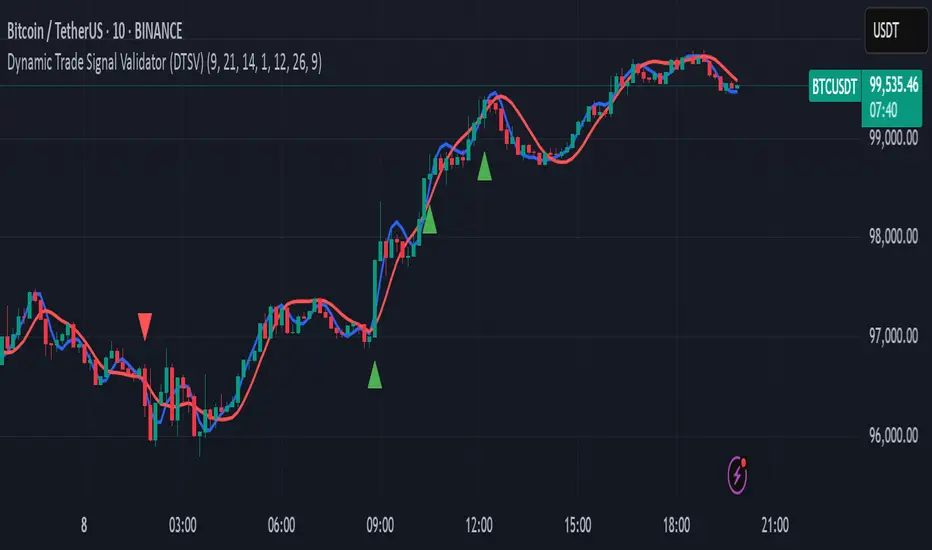OPEN-SOURCE SCRIPT
Dynamic Trade Signal Validator (DTSV)

The Dynamic Trade Signal Validator (DTSV) is designed to filter false trade signals while generating reliable, frequent trade opportunities. False signals, which lead to unprofitable trades, often occur in choppy or low-momentum markets. The DTSV combines Hull Moving Average (HMA) crossovers, Average True Range (ATR) breakout confirmation, and MACD histogram momentum filtering to ensure signals align with trend, volatility, and momentum, making it ideal for day trading or swing trading across assets like stocks, forex, or cryptocurrencies.
How It Works
The DTSV uses three components to validate trade signals, balancing frequency and reliability:
Signal Generation
Buy signals (green triangles below bars) occur when a bullish HMA crossover, ATR breakout, and positive MACD histogram align. Sell signals (red triangles above bars) require a bearish crossover, ATR breakout, and negative histogram. This triple confirmation minimizes false trades while maintaining frequent signals.
How It Works
The DTSV uses three components to validate trade signals, balancing frequency and reliability:
- HMA Crossover for Trend Direction:
Two HMAs (default: 9-period fast, 21-period slow) detect trend changes. A buy signal triggers when the fast HMA crosses above the slow HMA (bullish), and a sell signal when it crosses below (bearish). HMAs reduce lag compared to traditional MAs, enabling more responsive trend detection.
- ATR Breakout Confirmation:
The 14-period ATR ensures significant price movement by requiring the bar’s range (high minus low) to exceed the ATR multiplied by 1.0 (adjustable). This confirms volatility, reducing false signals in stagnant markets.
- MACD Histogram Momentum Filter:
The MACD (default: 12, 26, 9) histogram confirms momentum. Buy signals require a positive histogram (bullish momentum), and sell signals need a negative histogram (bearish momentum), ensuring directional strength.
Signal Generation
Buy signals (green triangles below bars) occur when a bullish HMA crossover, ATR breakout, and positive MACD histogram align. Sell signals (red triangles above bars) require a bearish crossover, ATR breakout, and negative histogram. This triple confirmation minimizes false trades while maintaining frequent signals.
Open-source script
In true TradingView spirit, the creator of this script has made it open-source, so that traders can review and verify its functionality. Kudos to the author! While you can use it for free, remember that republishing the code is subject to our House Rules.
🚀🚀🚀🚀
Automate TradingView Alerts
tradingviewlink.com/invite?ref=aff_9eq2
🤖🤖🤖🤖
Disclaimer: TradingView Link (tradingviewlink.com) is an independent brand and is not affiliated with, endorsed by, or associated with TradingView.
Automate TradingView Alerts
tradingviewlink.com/invite?ref=aff_9eq2
🤖🤖🤖🤖
Disclaimer: TradingView Link (tradingviewlink.com) is an independent brand and is not affiliated with, endorsed by, or associated with TradingView.
Disclaimer
The information and publications are not meant to be, and do not constitute, financial, investment, trading, or other types of advice or recommendations supplied or endorsed by TradingView. Read more in the Terms of Use.
Open-source script
In true TradingView spirit, the creator of this script has made it open-source, so that traders can review and verify its functionality. Kudos to the author! While you can use it for free, remember that republishing the code is subject to our House Rules.
🚀🚀🚀🚀
Automate TradingView Alerts
tradingviewlink.com/invite?ref=aff_9eq2
🤖🤖🤖🤖
Disclaimer: TradingView Link (tradingviewlink.com) is an independent brand and is not affiliated with, endorsed by, or associated with TradingView.
Automate TradingView Alerts
tradingviewlink.com/invite?ref=aff_9eq2
🤖🤖🤖🤖
Disclaimer: TradingView Link (tradingviewlink.com) is an independent brand and is not affiliated with, endorsed by, or associated with TradingView.
Disclaimer
The information and publications are not meant to be, and do not constitute, financial, investment, trading, or other types of advice or recommendations supplied or endorsed by TradingView. Read more in the Terms of Use.